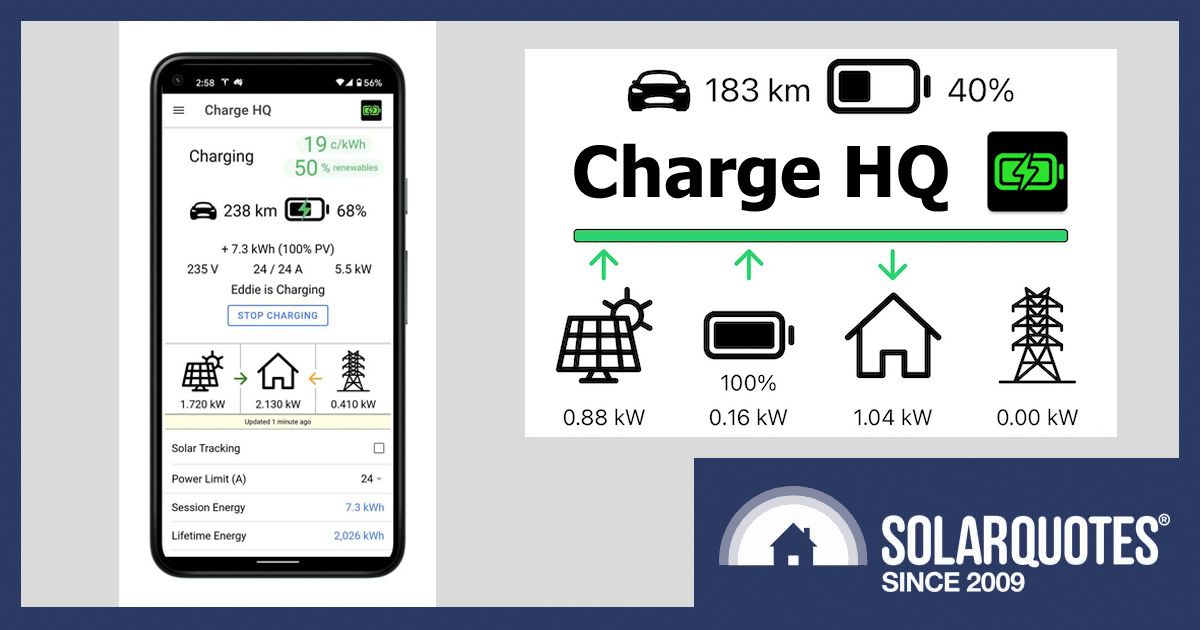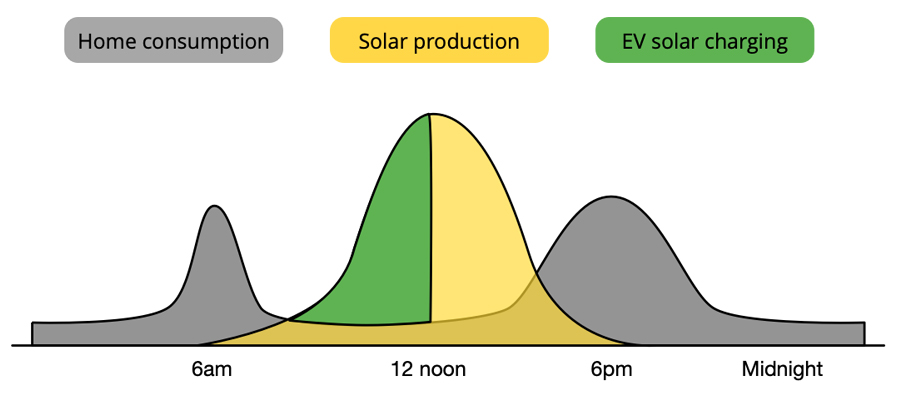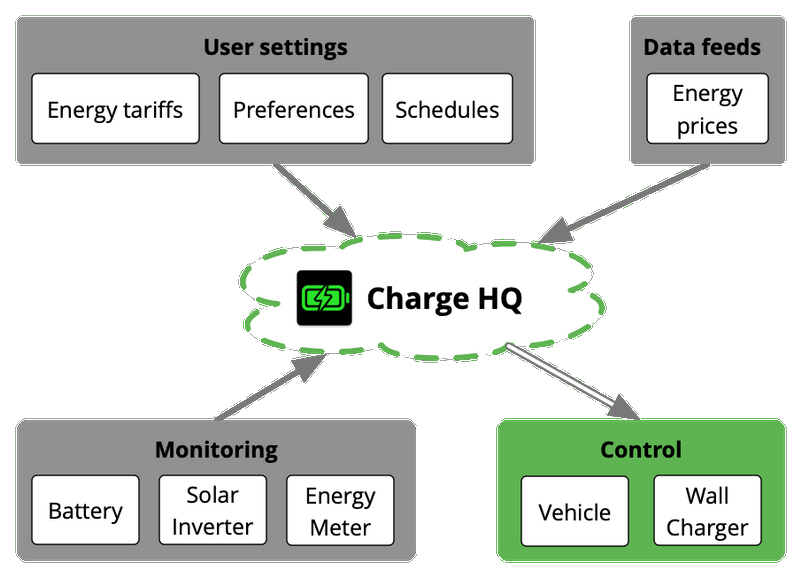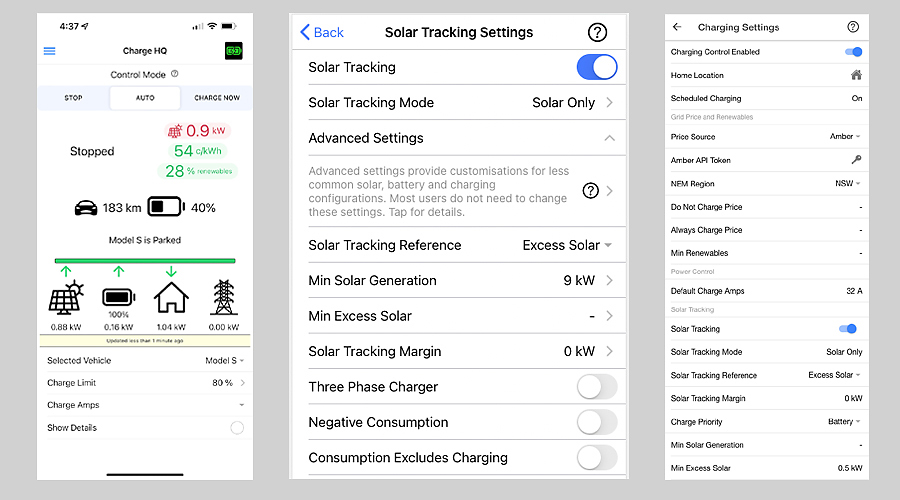
As electric vehicle ownership accelerates in Australia, new EV owners face the challenge of charging their cars as cheaply and conveniently as possible.
Update June 2023: Charge HQ Exits Beta, Introduces $7 per month subscription.
The cheapest way to charge an electric car in Australia is – when possible – to take advantage of negative wholesale electricity prices through a service such as Amber. You can get paid for filling up your car.
The next cheapest electricity source for your EV is home solar followed by off-peak electricity.
Charging from solar panels can be achieved with a hardware solution – just look for a charger with ‘smart solar’ charging on our EV charger comparison table. Almost all electric cars will also let you charge from off-peak via simple timers.
But what if you want to combine solar charging and Amber? Or what if you need to coordinate a home battery into the mix?
Depending on your hardware mix, that can get difficult really quickly:
One solution to synchronising your EV charging is via software that talks to the individual hardware components and coordinates them1.
A new Australian app, Charge HQ, aims to do just this by analysing factors in your home in real-time, such as solar production, energy consumption and wholesale electricity tariffs, adjusting your EV charging rate to match.
It’s early days now, as Charge HQ is still in beta. However, they already have more than 1,000 users, and it’s currently free to use by anyone with compatible equipment. Simply download it from your relevant app store. There’s also a web app that can be used in parallel with the mobile app.

Charge HQ adjusts the charge rate of your EV in real time to match excess solar production until full. Image: Charge HQ
Recently I interviewed Andrew Rodgers, the co-founder of Charge HQ. Here’s what he had to say…
SolarQuotes: Can you tell me, Andrew, why would an EV owner need an app to charge their vehicle, and what does your app do that a smart charger doesn’t?
Charge HQ: “The Charge HQ app allows users to charge their EVs from excess rooftop solar. Rather than sending your excess solar energy to the grid for a low feed-in tariff, you can download this app, have it set up in ten minutes, and start using excess solar to reduce the amount of grid charging overnight.”
SolarQuotes: Would a user need solar installed in their home to use your app? If not, what are the advantages of using the Charge HQ app?
Charge HQ: “You don’t have to have solar to use the app, but the vast number of users have solar installed in their homes. For the people that don’t have solar, there are some flexible controls in the app that you might not get with an EV charger.”
“For example, you can define scheduled charging periods based on the day of the week, or to take advantage of off-peak time-of-use tariffs. Powershop has very cheap rates between midnight and 4 am, so the app could turn on at these times. If you’re an Amber customer you can use it to respond to low or negative power prices.”
SolarQuotes: The FAQ section on your website says: “In many instances when your EV charges from grid energy, if you have a home battery system, the battery will discharge energy while the car is charging, and there’s a view that charging your EV battery from your home battery is sub-optimal, for several reasons…” You go on to say that “there are workarounds for this.”
Given Charge HQ is still in the beta phase, will addressing this be a priority for you before bringing the product to the market, or are the workarounds you suggest adequate?
Charge HQ: “Most smart chargers monitor the flow of energy in and out of the home battery but not the state of charge. It comes down to using an API to give us a bit more information about the battery, and so flexibility in what we can do to be more battery aware.”
“It’s still difficult to totally stop a home battery from discharging, but we have ideas about how we can solve it, and it’s near the top of our list on the road map ahead.”
SolarQuotes: So, is the issue now that the home battery can’t tell the difference between an EV battery and other household loads?
Charge HQ: “Yes, that’s correct. A common scenario is that during the day the EV will charge from the solar and that’s fine, the home battery will stay out of the way. But then in the evening, the EV battery might need a top-up, and it just looks like any other load to the home battery, so will discharge accordingly. We think it’s possible that the software can talk to the home battery and say, for example, at midnight tell it to stop discharging.”
“It varies depending on the battery as well. For example, I have a Powerwall at home, and I’ve noticed lately that it’s got its own mechanism, so if I tell it to charge in response to my time-of-use tariff it tends not to discharge very much overnight while my EV is charging. So there’s a bit of a nuance, and the experience varies depending on the battery model and configuration.”

Charge HQ app flow chart. Image: Charge HQ
SolarQuotes: Why does the app set a control limit of 90% charge during the day, and 60% overnight?
Charge HQ: “The default setting is just a starting point, and is totally customisable. The idea of having a lower setting overnight is so you can maximize the use of excess solar the following day. Everyone has a different routine, and after a while will adjust these settings to suit their own set of circumstances.”
SolarQuotes: Regarding a user who might have home consumption monitoring vs no consumption monitoring, your website says: “If a consumption meter is present Charge HQ can divert the excess solar to EV charging. For example, if you turn on your oven, Charge HQ will reduce the EV charging power to avoid importing from the grid.”
I think this feature alone would be enough to make me get the app. What other features do you think would get people over the line and convince them to download the app?
Charge HQ: “The fact that you can download this app and start using it immediately at no cost without buying any extra hardware is a no-brainer. The software approach gives us huge flexibility in what we’re able to do. We have, and will continue to add more features like this.”
SolarQuotes: I read Charge HQ is primarily used for charging at home and gives priority back to the vehicle for charging on the road. I can think of a function that might be useful when charging from the street verge or on the road. Could the app notify the owner if the cable was removed and so help prevent charger cable theft?
Charge HQ: “We can even do better than that. The app has the capability to talk to the charger and lock the cable in place to avoid theft. This is a new feature and so is not currently updated on our website at the moment.”

Charge HQ app interface showing solar tracking and charging settings. Image: Charge HQ
SolarQuotes: Do you think Charge HQ will have a role when, or if V2G (Vehicle to Grid) becomes the norm, and perhaps reduce or eliminate the need for a home battery? Maybe you could have a feature called “Discharge HQ”?
Charge HQ: “I like the name. If V2G becomes a thing we’re very well-positioned to deal with it. There are two schools of thought on that. In a world where we’re going to have more renewables in the future, an important first step is soaking up that excess solar energy with things such as EV batteries.”
“Then discharging them to meet overnight demand becomes complicated. The more we discharge then the quicker the battery gets degraded and impacts the vehicle. It’s early days to know where that balance lies. As battery technology changes, so do variables such as battery degradation and range anxiety, etc.”
SolarQuotes: Are there any other apps that you are aware of that function similarly to Charge HQ?
Charge HQ: “Nothing that integrates with solar in the same way. I think that Australia is a unique market because we have so much rooftop solar installed and we also have an electricity tariff structure that incentivises people to use that solar.”
SolarQuotes: When do you think Charge HQ will be out of the beta phase?
Charge HQ: “We have a set of features that we’re working towards that we feel need to be there to be out of beta, with our target being the first quarter of next year. One that we’re working on at the moment is a recording interface that will show statistics and data about your charging history.”
SolarQuotes: So, how can someone download Charge HQ?
Charge HQ: “Just search for Charge HQ on the Google Play Store (Android) or the App Store (iPhone), download, and install. Check the list of supported hardware and you can be up and running in ten minutes. There’s also a very comprehensive FAQ section on the website.”
Footnotes
- Be aware – you still need compatible hardware with an open API. In the video above, Tom’s SolarEdge inverter has this, but the Sonnen battery, Zappi 2 charger, and Nissan Leaf do not. ↩

 RSS - Posts
RSS - Posts



Interesting article.
Our grid plan through Red Energy, no longer price differentiates between peak, shoulder and off-peak; all are now at the same rate.
The article might like to nominate which companies still offer a differentiated time-based grid supply?
Hi Ex-engineer. There’s an electricity plan comparison tool here if it helps?
https://www.solarquotes.com.au/energy/
Extraordinarily cool work by ChargeHQ, I hope they continue to refine and get an even cleaner version in the market soon.
I installed it last week, combining data from my Solar Analytics hardware, a Wallbox Pulsar Plus charger and ChargeHQ to manage the charge to my Harley Livewire. It was like watching some weird magic in real time over the weekend as it all talked together and seamlessly adjusted everything.
I’ve also got a small household Battery and a Catch Power diverter – was fascinating watching everything fighting for control as I tested the various functions.
My 2c worth! I query the fixed rate for Red? Tried to look at the current rates but they seem not to be accessible (not do the Kwh rates for TOU seem to be accessible). I am a current Red customer on a rate fixed to next year. Then who knows!
I got a ZJBeny OCPP charger for evaluation when I was a voluntary Energy Coach with Enova Energy (now sadly demised). I have just got this charger working with the Home Assistant software package, by using the H/A OCPP module. By using this well supported Open Source package that runs on a Rpi, or dedicated x86 computer, I will (eventually) have total control of my house & Energy usage inc our EVs. With Home Assistant the times & rates can be programmed in, as well as allowing Current control for Maximum demand & ensuring the grid demand is controlled to. This can be tied to Solar Pv production too if you wish. refer
Home Assistant on https://www.home-assistant.io for more info (Not for the average user, Nerds only need apply!)
ChargeHQ seems to be a good idea. Australia definitely needs a way of controlling EV charging to alleviate the possible grid overload at peak demand times. The use of a Wholesale tied Electricity account to me seems to me to be risky, & possibly aimed at the crowd who invested in Bitcoin! (TIC)
ChargeHQ will also be checking the ZJBeny OCPP charger. As the ZJBeny OCPP runs on SteVe, & Home Assistant, I think it will be fine on Charge HQ.
regards, Doug
Hi Doug. I have an article coming out soon about someone who’s done the same thing as you with Home Assistant, so you’ll be in good company. It would be good to get your thoughts. I’ll keep you posted.
Hi Doug. Here’s the article I was talking about:
https://www.solarquotes.com.au/blog/solaredge-home-assistant-hack
Unfortunately our brand new Ocular LTE charger isn’t on the list. Oh well.
We don’t drive that much.. I think I’ll just plug it on on sunny days.
To add to my 2c worth: I am not a fan of charging an EV battery from a home battery. In my case, my battery is 12Kw, & my EV battery 64Kw. My home battery balances my use between 17:00 & abt 22:00. If I charged from my battery, I would be paying for peak energy for my home use! Add to that is the losses charging then discharging the battery.
My EV charger is connected on the Grid side of my battery (& also the Victron relay for Grid backup). As long as the EV demand is measured, & managed, i can still use my excess PV energy. One needs to keep in mind the potential losses charging an EV: many EVs are inefficient at 6A, & that is why the portable chargers are usually 9A. Personally, I usually charge my EV at 20>30A, after my Home battery is charged (usually abt 10am.)
Brilliant technology.
The complexity of negotiating these new interfaces between EVs, homes, batteries, panels, off-peak grid etc. makes me still wonder how much distributed energy generation and storage you can have on a grid before it overwhelms the capacities of many users. For enthusiasts it’s fun, but for maybe the majority of the public way above what they’ll ever possibly be able to manage, even with cool apps. From the engineering point of view I’m curious where societies will land with this, I’m guessing we’ll end up back with a more centralised model.
Nick, I understand your position. It always worries me who will look after my system when I am no longer able to manage it.
However, I can see the potential here too. I think there will be service providers that will support these solutions. Home Assistant is a good example: an Open Source total home management solution that can control not only your overall Energy management, but is able to interface Mobile apps that can control lights, equipment, sound systems, AV devices etc etc. There is even a module for Internet ad management (Adguard home). This system is supported by major manufacturers too. Because this type of overall management will become more common, I can see third party support organisations remotely managing these solutions. I feel these open source solutions are the best future option because one is not locked to a closed source solution, where the managing company might be taken over or go into receivership.
Personally I have set up Home Assistant on an Intel NUC. So far my car charger is interfaced, & I am reading the data from my inverters & battery system. The house consumption is read by an IoTaWatt system that has 14 inputs available & interfaces easily to the Home Assistant platform. I have Adguard installed too. This has reduced the computers in my house that remain on because I have the possibility of controlling my water tanks & pumping too (An important consideration on a rural setup.) Still early days but the potential seems enormous.
Thanks Doug. I think back to something Steve Jobs said a lot (paraphrasing), that until computers are as easy to use as washing machines, they’ll never achieve genuinely mass use. iPads are an example of how he imagined that, without anybody having to navigate a file system, so progress has been made.
I think of the number of people I know who really have no clue with technical things. They need things to just work. People like my mum, they can learn some of the technicalities, but they quickly tire of it. Maybe we’ll end up with an overall system that allows enough pottering for the enthusiasts, but ‘just works’ for everybody else, best of both worlds.
I have been charging my Tesla Model 3 for two and a half years through a Zappi EVSE. A brilliant product. I recently downloaded Charge HQ and find that it is even better than my Zappi as it can see my LG Chem DC coupled battery. I am looking forward to the next version of Charge HQ and hope that it reasonably priced when they progress from the free beta version. Definitely worth using. The type of EVSE that you have is irrelevant. My Tesla and SolarEdge inverter are fully supported and I am currently operating my Zappi in dumb mode with Charge HQ making all of the decisions.
Hi John,
I agree – ChargeHQ’s ability to talk to batteries makes it much better than a Zappi.
But the EVSE type is only irrelevant if your car can talk to ChargeHQ. At the moment only Tesla cars can talk to ChargeHQ.
If you have any other EV, you need an OCPP compliant EVSE that works with Charge HQ.
For example I have a Tesla and an electric Mini, so I got a Delta AC Max charger. That means both cars are controlled by ChargeHQ.
I enjoy SolerQuotes Blog, and I used your quote system to get our solar panels. However, as Nick alluded to in the comments, the “ nerdy” techy language creeping into all the interviews and comments is starting to become a little frustrating in maintaining my understanding and knowledge.
I keep an eye on our PV production/consumption with our software, but don’t own (or contemplate at this stage) an EV. But the more I see of these interviews and comments with the technical language being introduced, the less enthusiastic I become.
Hey Tim,
What particular jargon in this blog post did you find frustrating?
Finn
I should clarify. I don’t mind the technical stuff (I’m an engineer). For many if not most of the public though, I think mass adoption will require this all to be relatively seamless, as their power supply is to them now. They plug in, and switch on.
That’s what I like about my Charge HQ setup whether it’s the Tesla or the Mini, we just plug in and go and know we’ll be charging on solar and not touching the home battery. If we are in a hurry and its terribly overcast, we just hit ‘charge now’ on the app to override everything.
Only problem is the charger crashes occasionally and needs a power reset… This will hopefully be fixed soon – I suspect it is a firmware issue for Delta.
Sounds like they’re on the pathway to seamlessness. Though also I think it’s fair to expect people to acquire a little bit of new knowledge as times change! My mum has come a long way…but at the end of the day if it needs much thought or action, it won’t happen on a mass scale, in my experience.
I wouldn’t want to be an electrical engineer coping with the new grid design and management of all of these competing elements, at the same time trying to make it almost invisible to consumers. The next decade will be like a moon landing a year in terms of challenges to be overcome.
I apologise to Tim if he felt my comments were nerdy. I admit I am a Nerd!
I also love EVs, & currently I am setting a friend up with an EV charger. She just needs something that works, so I am setting her up with a fairly simple charger.
I feel a lot of fear of EVs is because normal people think it is easier to fill a car with fuel, then just drive. The reality of owning an EV is you do the same thing, but stop more often. My car has a range of over 400Kms & I recently did a 2000km trip. Left N Rivers NSW, charged near Port Macquarie (~360Kms), then topped off at Karuah. I charged at Sydney Olympic Park, then next day drove to Lithgow & charged, then weekend at Dubbo (where we charged again). Few days later, return, topping up at Lithgow, then Sydney, Karuah, Port Macq, then final short top off at Grafton to return home. Probably spent 8 hours charging overall for that trip, but the cost is Much lower than Petrol/Diesel (40%>70% cheaper). Also the maintenance costs are much lower. At home we mostly charge from excess solar. I only ever use a fast charger if I am a long way from home. I feel EVs are the future.
I also need to say that yes, perhaps I am ahead of the pack, but the commercial end user solutions will come from our Pioneering steps.
On range anxiety, a great story rarely told is that when petrol cars were introduced, there were no service stations. People had to buy fuel in tins at their local shops and lug it home. It took decades for proper refuelling to be built, via service stations. By comparison EV recharging is rolling out much faster.
The EV charging 101 webpage is very useful ( https://www.solarquotes.com.au/electric-vehicles/ev-charging-guide/ ).
I am looking at installingnan EV charger. I have a PV system with Solaredge Inverter and a Tesla Powerwall 2.
Finn’s article suggests several features to consider to optimise use of solar and (optionally) ensuring the battery gets priority and it not used for charging the EV.
My research suggests that it will be difficult to achieve this by simply adding an EV charger to the existing system – cost around $2000?
The other option is to replace the Solaredge inverter with the Solaredge Inverter and EV charger that has the optimisation features built-in. I am waiting on a quote for this. The current inverter is only 5 years old somit seems wasteful but may be the best option in the longer term.
I would appreciate feedback from EV owners who have installed the Solaredge inverter/charger.
I have realised that ChargeHQ might give me more choices – wil look into it!
BTW one installer told me that the SolarEdge Inverter/Charger needs to be located close to the EV, which is no good for my current PV/Powerwall system (about 15m away). Also the device costs around $4000.
SolarEdge are about to launch an EV charger that should be able to talk to existing inverters. The SolarEdge website already has a brochure on the charger:
https://www.solaredge.com/aus/ev-charger